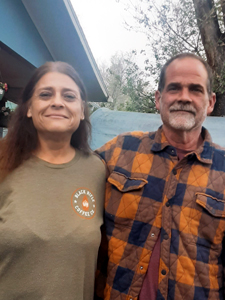 Marcia Niemann is a strong woman and her husband, Brian Niemann, knows it. Years ago, she’d had her appendix removed and overall, “she’s usually got a high tolerance for pain, like most women seem to,” he said. That’s why he grew concerned one day when she complained of a stomach pain that left her doubled over and seemed to only be getting worse.
Marcia Niemann is a strong woman and her husband, Brian Niemann, knows it. Years ago, she’d had her appendix removed and overall, “she’s usually got a high tolerance for pain, like most women seem to,” he said. That’s why he grew concerned one day when she complained of a stomach pain that left her doubled over and seemed to only be getting worse.
“She didn’t feel right that morning, through the night and into the following morning, (at) 2 o’clock in the morning. She hung on as long as she could because she didn’t want to go to emergency, because she knows how much that can be,” Brian explained.
Eventually, Marcia couldn’t hold off any longer and she and Brian sought emergency treatment at Penrose Hospital in Colorado. Upon arrival, Brian said the medical staff couldn’t figure out what was wrong with Marcia and even getting her IV was worrisome.
“The person who gave her IV apparently didn’t know what she was doing — she must have been new at it — and when I walked in later, there was blood all over the place, all over the floor, on her jacket, and on her, because they screwed up. So, the other nurse that was there had to take over,” he said.
Marcia also got a blood test and received medicine for nausea and Irritable Bowel Syndrome — the doctor’s initial diagnosis, Brian said. Marcia remained in the emergency room for about four hours.
Because the medicine Marcia got didn’t help much, Brian took it upon himself to look up her symptoms online and came up with a more accurate diagnosis. “I was off (of work) the following day, so I researched it myself. And I said, ‘Marcia, I don’t think you’d have anything they said you have. I think you have an ulcer.’”
Brian learned that Prevacid is used to treat ulcers, so he called his daughter and asked her to buy some for Marcia. “Thirty minutes after she took the Prevacid, she felt better,” he said.
For his wife’s emergency room “treatment,” as Brian describes with air quotes, the couple was billed nearly $2,500. “They made her bleed all over the place and didn’t even diagnose her correctly… Our reaction was, thousands of dollars for what?” Brian said. He still finds the bill “ridiculous.”
Brian works at a grocery store, while Marcia is a stay-at-home grandmother. At the hospital, he’d been told that with his insurance, he’d have to pay a copay of $462. He said he was never told he could get assistance for that or any of the bills that followed.
He thought he’d have to start making payments using credit cards, but then he heard about Dollar For. “One of the local TV stations had mentioned Dollar For. I’d never even heard of it. I didn’t know you could work with a hospital and (that) they had money set aside for people who are lower income. I did not know,” Brian said.
Brian was skeptical about reaching out to Dollar For, but decided the news channel was a reliable source. He said after filling out the initial questionnaire, he quickly heard from the organization about next steps to tackle his wife’s new medical debt.
“Once I filled out the forms, with my income and everything, I was underneath their poverty levels. And (the hospital) said it would take care of it,” he said. He estimates it took “four to six weeks,” to resolve.
“That took that burden off, and they gave me my $462 back…it was nice to have back because it ended up going towards Christmas,” Brian said with a laugh.
Brian knows he took care of his wife and her medical needs as best as he could. And he would advise anyone in need of care to ask about programs that assist families with medical bills. “The hospital will not tell you,” he said.
He called Dollar For a “godsend,” saying: “You don’t think there’s something out there and then you find out there is something that can help you.”
The state of Colorado has laws that require hospitals to offer charity care. Read about other Coloradans who crushed their medical bills: Lindsey, Janis, and Michele.
